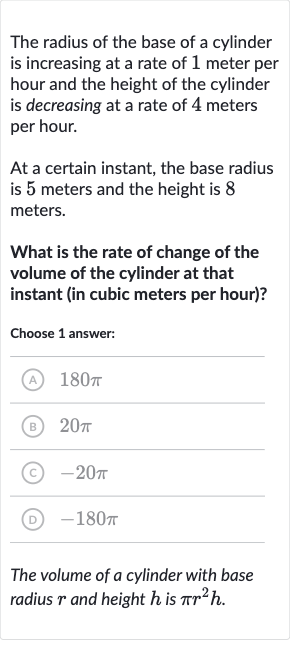AI tutor
Welcome to Bytelearn!
Let’s check out your problem:

The radius of the base of a cylinder is increasing at a rate of meter per hour and the height of the cylinder is decreasing at a rate of meters per hour.At a certain instant, the base radius is meters and the height is meters.What is the rate of change of the volume of the cylinder at that instant (in cubic meters per hour)?Choose answer:(A) (B) (C) (D) The volume of a cylinder with base radius and height is .
Full solution
Q. The radius of the base of a cylinder is increasing at a rate of meter per hour and the height of the cylinder is decreasing at a rate of meters per hour.At a certain instant, the base radius is meters and the height is meters.What is the rate of change of the volume of the cylinder at that instant (in cubic meters per hour)?Choose answer:(A) (B) (C) (D) The volume of a cylinder with base radius and height is .
- Write Formula: First, write down the formula for the volume of a cylinder, which is .
- Find Rate of Change: Next, we need to find the rate of change of the volume, which is . To do this, we'll use the chain rule from calculus, since is a function of both and , which are both functions of time .
- Apply Chain Rule: The chain rule gives us . We know (since the radius is increasing at meter per hour) and (since the height is decreasing at meters per hour).
- Calculate Partial Derivatives: Now, calculate the partial derivatives and . The partial derivative of with respect to is , and the partial derivative of with respect to is .
- Plug in Values: Plug in the values of and into the partial derivatives. We have meters and meters, so and .
- Calculate Derivatives: Now, calculate the actual values of the partial derivatives. and .
- Find : Finally, plug in all the known values into the chain rule equation to find . .
- Final Calculation: Calculate . cubic meters per hour.
More problems from Area of quadrilaterals and triangles: word problems
QuestionGet tutor help
QuestionGet tutor help
QuestionGet tutor help
QuestionGet tutor help
QuestionGet tutor help
QuestionGet tutor help
QuestionGet tutor help
